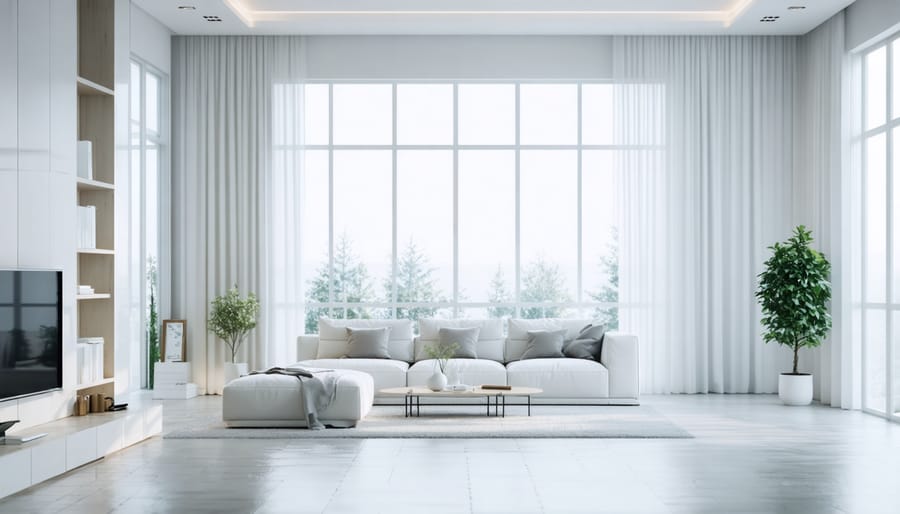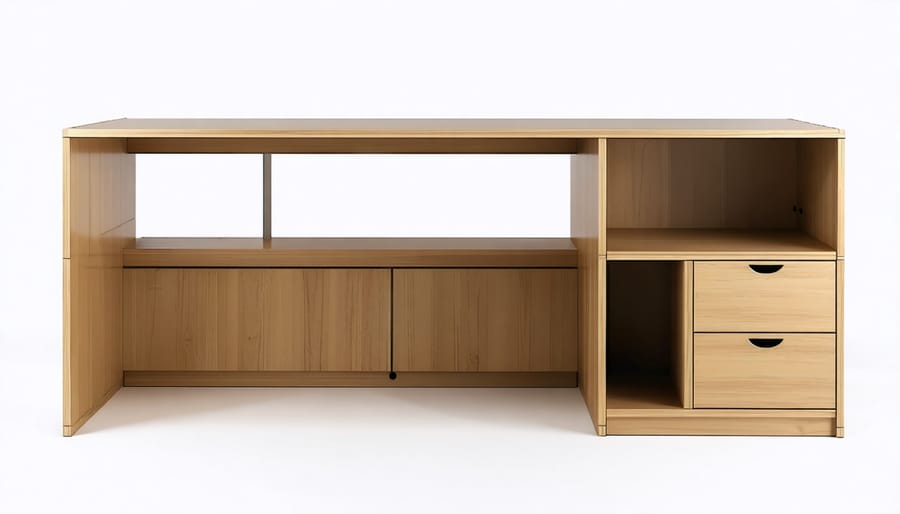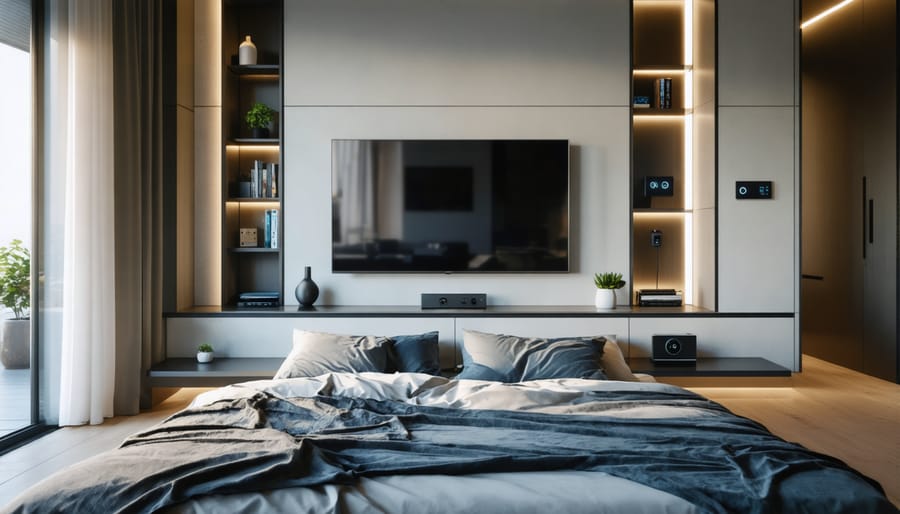
Modern Minimalist Magic: Transform Your Home with Clean Design
Transform your living space into a serene sanctuary by embracing modern minimalist interior design styles that prioritize function and visual clarity. Strip away unnecessary decor and adopt a “less is more” philosophy, focusing on clean lines, purposeful furniture, and neutral color palettes that create a sense of calm and spaciousness. Select multi-functional pieces that serve both practical and aesthetic purposes – think built-in storage benches, wall-mounted desks, or floating shelves that maintain visual simplicity while maximizing utility. Integrate smart home technology seamlessly into your design through hidden cables, recessed lighting, and wireless charging stations that preserve the clutter-free aesthetic while enhancing modern convenience. Emphasize natural light and organic materials to add warmth and texture without compromising the minimalist principles, creating a sophisticated yet livable environment that promotes both mental clarity and everyday functionality.
Core Principles of Modern Minimalist Design
Less is More: The Art of Decluttering
The art of decluttering is fundamental to achieving a truly minimalist space, and it starts with embracing Japanese minimalist design principles that emphasize the beauty of empty space. Begin by evaluating each item in your home with three simple questions: Do I need it? Do I use it regularly? Does it bring genuine value to my space?
Create designated zones for essential items and implement the “one in, one out” rule – when you bring something new home, remove something old. Smart storage solutions, like built-in cabinets and multi-functional furniture, help maintain clean lines while keeping necessities accessible but hidden.
Consider displaying only items that serve both functional and aesthetic purposes. A carefully chosen vase, for instance, can act as both storage and decor. Digital solutions can help reduce physical clutter – scan important documents, opt for e-books, and use smart home technology to eliminate unnecessary gadgets.
Remember, decluttering isn’t a one-time project but a mindful, ongoing practice that helps maintain the peaceful atmosphere of your minimalist home.
Color Theory in Minimalist Spaces
In minimalist design, color plays a crucial role in creating a harmonious and balanced space. The key to success lies in establishing a cohesive color scheme centered around neutrals, with thoughtful accent colors adding personality and depth.
Start with a foundation of whites, grays, or warm beiges as your primary palette. These neutral tones create a sense of calm and spaciousness while serving as the perfect canvas for your minimalist aesthetic. Consider using different shades of the same neutral color to add subtle depth without overwhelming the space.
When it comes to accent colors, less is definitely more. Choose one or two bold hues that complement your neutral base and use them sparingly through carefully selected pieces like artwork, throw pillows, or a statement chair. Popular accent choices include deep blues, forest greens, or muted terracotta, which add warmth without compromising the minimalist feel.
Remember that natural materials like wood, stone, or metal can contribute to your color palette while adding texture and visual interest. These elements help create a connection to nature and prevent your space from feeling sterile or bland.
Essential Elements of Modern Minimalist Interiors
Clean Lines and Simple Geometry
Clean lines and simple geometric shapes form the foundation of modern minimalist design, creating a sense of order and visual calm in your living space. Instead of ornate details and curved elements, focus on incorporating straight lines in your furniture choices and architectural features. Think sleek floating shelves, rectangular coffee tables, and square-edged sofas that emphasize simplicity and function.
When selecting decor pieces, prioritize items that feature basic geometric shapes like squares, rectangles, and circles. This could mean choosing a round mirror above a linear console table or arranging square artwork in a grid pattern. The key is to maintain balance while avoiding cluttered or complex arrangements.
Consider emphasizing these clean lines through your choice of window treatments, opting for simple roller blinds or floor-to-ceiling curtains that hang straight. Even lighting fixtures can reinforce this aesthetic – choose pendant lights with clear geometric shapes or wall sconces with minimal angles.
Remember that these straight lines and simple shapes shouldn’t feel harsh or unwelcoming. Balance them with soft textures in your upholstery and rugs to create an inviting atmosphere that remains true to minimalist principles.
Natural Light and Space Optimization
Natural light and open spaces are fundamental elements of modern minimalist design, creating an atmosphere of serenity and spaciousness. To maximize natural light, start by keeping windows unobstructed and using sheer or light-filtering window treatments that allow sunlight to pour in while maintaining privacy. Consider removing unnecessary walls or replacing solid doors with glass alternatives to improve light flow between rooms.
Strategic mirror placement can amplify natural light and create the illusion of more space. Position large mirrors opposite windows to reflect light deeper into your rooms and make spaces appear twice their size. Light-colored walls and reflective surfaces, such as glossy tiles or polished floors, further enhance this effect.
Open floor plans are essential for space optimization. Remove non-load-bearing walls to create multi-functional areas that feel more expansive and allow better light distribution. Keep furniture minimal and positioned away from windows to prevent blocking natural light. When selecting storage solutions, opt for built-in options that maintain clean lines and preserve open space, allowing natural light to remain the star of your interior design.

Smart Storage Solutions
In a minimalist home, smart storage is the secret weapon for maintaining those coveted clean lines and clutter-free spaces. The key is to think beyond traditional storage solutions and embrace innovative ways to hide everyday items while keeping them easily accessible.
Consider installing floor-to-ceiling built-in cabinets that blend seamlessly with your walls. When painted in the same color and finished without visible handles, these storage units virtually disappear while maximizing vertical space. Under-stair storage drawers offer another clever way to utilize often-overlooked spaces, perfect for storing seasonal items or rarely-used belongings.
Furniture that doubles as storage is a minimalist’s best friend. Look for platform beds with built-in drawers, ottoman coffee tables with hidden compartments, and floating entertainment units with concealed cable management systems. In the kitchen, opt for handleless cabinets and appliance garages that keep countertops clear while maintaining easy access to daily essentials.
Don’t overlook the power of drawer organizers and modular storage systems. These internal solutions help maintain order inside cabinets and drawers, ensuring everything has its place. Consider installing pull-out pantry systems, rotating corner units, and drawer-within-drawer configurations to maximize every inch of space.
Remember, the goal isn’t just to hide clutter – it’s to create intuitive storage solutions that enhance your daily routine while preserving the clean, uncluttered aesthetic that defines minimalist design.
Furniture Selection and Placement
Multi-functional Pieces
In a minimalist home, every piece of furniture should earn its place by serving multiple functions. Consider investing in a sleek ottoman that doubles as both seating and hidden storage, perfect for stowing away blankets or magazines. Wall-mounted desks that fold away when not in use create instant workspace without permanently sacrificing floor space, while modular sofas can be reconfigured to accommodate different social scenarios.
Smart furniture choices include expandable dining tables that can transform from intimate two-person settings to dinner party-ready arrangements, and platform beds with built-in drawers that eliminate the need for separate dressers. Look for coffee tables with adjustable heights that can transition from casual lounging to impromptu dining, and consider nesting tables that can be tucked away or spread out as needed.
For smaller spaces, murphy beds integrated with shelving systems offer the ultimate in space-saving versatility. Floating media consoles with built-in cable management keep entertainment areas tidy while providing display space for decorative items. Even simple pieces like bench seating in entryways can serve triple duty as shoe storage, a place to sit, and a surface for keys and mail.
The key is to think critically about each piece’s potential uses before bringing it into your space. This approach not only maintains the clean aesthetic of minimalist design but also maximizes functionality in your home.

Strategic Arrangement
In minimalist design, furniture placement is as crucial as the pieces themselves. Start by identifying the primary function of each room and arrange furniture to support these activities while maintaining clear pathways. For living rooms, position your main seating to create conversation areas, keeping at least 30 inches of walking space between pieces. When dealing with furniture for small spaces, consider multi-functional pieces that can be easily moved or transformed.
Create a natural flow by aligning furniture with architectural features like windows and doorways. Avoid blocking these elements, as they contribute to the open, airy feel essential to minimalist design. Position larger pieces against walls when possible, leaving the center of the room open to enhance the sense of space.
In bedrooms, center the bed on the main wall and maintain equal space on both sides for balance. For home offices, position desks to maximize natural light while minimizing screen glare. In dining areas, allow at least 36 inches between the table and walls for comfortable seating and movement.
Remember to incorporate negative space – empty areas that give the eye a place to rest. This doesn’t mean rooms should feel sparse; rather, thoughtfully arranged furniture should create purposeful zones while maintaining the clean, uncluttered aesthetic that defines modern minimalism.
Technology Integration in Minimalist Spaces
Hidden Tech Solutions
In today’s tech-driven homes, maintaining minimalist aesthetics while incorporating modern devices requires thoughtful planning. The key lies in creative concealment solutions that keep your space clean and uncluttered while ensuring full functionality.
Consider installing flush-mounted TV panels that seamlessly blend into walls when not in use. Many modern TVs offer art mode features, transforming screens into digital artwork that complements your décor. For sound systems, opt for in-wall or in-ceiling speakers that provide excellent audio without visible components.
Cable management is crucial for maintaining clean lines. Use wall channels to hide wires behind drywall, or install dedicated cable raceways that can be painted to match your walls. For charging stations, consider incorporating hidden power points inside drawers or installing pop-up outlets in kitchen counters or bedside tables.
Smart home hubs and routers can be tucked away in custom cabinet solutions or dedicated technology closets. Wireless devices like thermostats and security cameras now come in sleek, minimalist designs that complement modern interiors rather than disrupting them.
For home office setups, consider motorized desks that can conceal monitors and equipment when not in use. Built-in charging drawers and wireless charging pads integrated into furniture surfaces eliminate the need for visible cords and adapters, maintaining the clean aesthetic essential to minimalist design.

Smart Home Features
In a modern minimalist home, smart technology should enhance your lifestyle without creating visual clutter. The key is selecting devices that blend seamlessly with your clean aesthetic while offering practical functionality. Consider installing smart lighting systems with hidden strips and recessed fixtures that can be controlled via smartphone or voice commands, eliminating the need for visible switches and dimmers.
For climate control, opt for sleek smart thermostats in neutral colors that complement your walls. Many modern options feature minimalist displays that fade when not in use. Automated window treatments can be concealed within ceiling pockets, appearing only when needed and controlled remotely.
Hidden speakers integrated into walls or ceilings provide immersive sound without compromising your space’s visual harmony. Smart home hubs can be discretely placed in cabinets, while wireless charging pads can be built into furniture surfaces for invisible power solutions.
Security features like smart locks and doorbell cameras now come in streamlined designs that maintain clean lines while offering peace of mind. For maximum efficiency, integrate these systems through a single app interface, reducing digital clutter just as you’ve minimized physical clutter.
The goal is to create an environment where technology serves your needs invisibly. Choose devices with simple, understated designs and consider how they’ll integrate with your interior before installation. This thoughtful approach ensures your smart home features enhance rather than detract from your minimalist aesthetic.
Embracing modern minimalist design in your home is more than just a style choice – it’s a transformative journey toward purposeful living and mindful spaces. Throughout this guide, we’ve explored how clean lines, thoughtful furniture selection, and smart storage solutions can create a harmonious living environment that promotes both functionality and tranquility.
Remember that minimalism doesn’t mean sacrificing comfort or personality. Instead, it encourages you to curate your space intentionally, keeping only what truly adds value to your daily life. Start small by decluttering one room at a time, incorporating multi-functional furniture, and embracing neutral color palettes with strategic accent pieces.
The beauty of minimalist design lies in its flexibility – you can adapt these principles to suit your lifestyle and preferences. Whether you’re drawn to Scandinavian influences, Japanese zen aesthetics, or contemporary industrial elements, the core principles of simplicity and purposefulness remain constant.
As you begin your minimalist journey, focus on quality over quantity, invest in pieces that serve multiple purposes, and don’t be afraid to edit your space regularly. The result will be a home that not only looks sophisticated and modern but also supports your well-being and productivity through its thoughtful organization and calm atmosphere.
Take the first step today – choose one area of your home and begin applying these minimalist principles. You’ll be amazed at how transformative this approach can be, both for your living space and your daily life.
